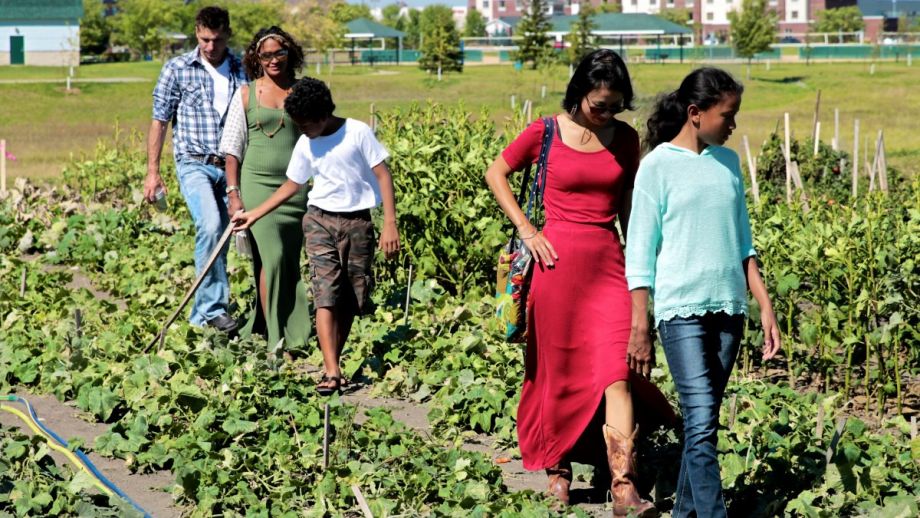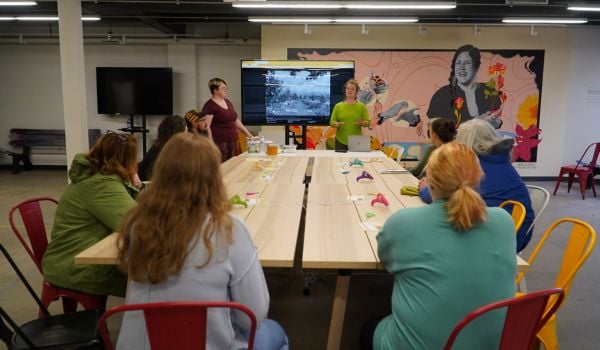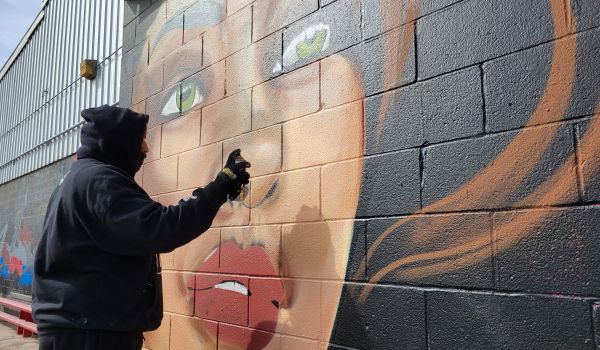Rabanus Park in Fargo, North Dakota, was a large, empty field for many years. The park had sat vacant and rarely used in the middle of the otherwise busy, diverse neighborhood of West Acres since the early 2000s. That’s when the city declared it water drainage basin, creating a large indented area designed to catch and store water when too much rain fell on the flat, flood-prone city situated in the Red River Basin.
For more than a decade, this 18-acre sponge sat underused — an unwanted, muddy space that had been created without much input from the residents now forced to avoid it in their daily travels around the neighborhood.
But in 2015, all of that changed when Rabanus Park became the World Garden Commons. Today, the Commons functions not only as place to capture stormwater but as a community garden, play area and restored urban prairie. New immigrants who live in the area grow vegetables and fruits that remind them of home in the new garden and families gather in the natural play area and a nearby listening garden.
The transformation — led by community leaders, artists, the late environmental artist Jackie Brookner, and city planner Nicole Crutchfield — was sparked by a small but impactful National Endowment for the Arts program that since its inception in 2010 has been the federal government’s largest single investment in creative placemaking.
Among the place-based programs pioneered under the Obama Administration, the National Endowment for the Arts’ Our Town program has awarded 389 grants totaling $30 million dollars.
The grants have been awarded to communities in all 50 states, two territories (Washington, D.C., and Puerto Rico) and many Native American tribes. The majority of these grants have been awarded to communities with a population of less than 100,000 people, places where funding for the arts is typically scant. Nearly half of all recent NEA grants were specifically designed to reach high-poverty neighborhoods.
But while the program has made a difference across red and blue America, there are no assurances it will continue under the Trump Administration. The NEA is an independent agency of the federal government run by a chairman who is appointed by the President and confirmed by Congress. So far, the only candidate publicly floated for the job has been Sylvester Stallone, who later indicated that he would not accept the post if it were offered. The NEA has long been a target of conservatives who object to the use of taxpayer money on the arts on ideological grounds and those who want to cut federal spending and see the agency as a frill. Trump himself has given no indication of his vision for public investment in the arts and according to The New York Times, is not known as a major arts benefactor in New York.
When the Washington Post asked during the run up to the election about the role of the federal government in funding art and how he would fund the NEA, Trump deferred to Congress — now with a Republican majority — offered only very general statements about the value of a “liberal arts education.” He did not mention the federal agency by name.
“The Congress, as representatives of the people, make the determination as to what the spending priorities ought to be,” Trump said, later adding that “a holistic education that includes literature and the arts is … critical to creating good citizens.”
Just before Trump’s inauguration, The Hill reported that the NEA as a whole might be on the chopping block as part of a plan (which would not be finalized until April) to cut federal spending on arts, civil rights, and environmental initiatives. These cuts would not make a significant dent in federal spending — leading many to call them symbolic. Symbolic or not, the cuts will be felt by American communities large and small, especially those who cannot depend on the market to support their work.
Our Town launched in 2010 as a way to increase support to precisely those cultural communities and art projects that aren’t likely to be sustained by traditional sources. The NEA was particularly interested in reaching grassroots organizations working outside of arts institutions. That year, two consultants working with the NEA issued a white paper that would set the stage for the new program by coining the term “creative placemaking.” “In creative placemaking, partners from public, private, nonprofit and community sectors strategically shape the physical and social character of a neighborhood, town, city or region around arts and cultural activities,“ wrote authors Ann Markusen and Anne Gadwa.
The definition of the term has evolved and been debated since its inception, notably to ensure that creative placemaking work is intentional about being led by and accountable to the communities the work seeks to impact.
In addition to funding Our Town, the NEA instigated a new partnership with national foundations, financial institutions and other federal agencies, called ArtPlace America. To date, ArtPlace has invested $96 million in 262 community-based arts projects around the country. (Disclosure: I work as a contractor for Artplace America’s Research Strategies.)
Meanwhile, President Obama’s first appointee to chair the NEA, Rocco Landesman, looked at the comparatively low budget for his agency — which has remained flat for the past few years at $146 Million — just 0.012 percent (one one-hundredth of one percent) of federal discretionary spending — and saw an opportunity. Creative placemaking was a way to make the dollars go farther on the ground in communities. “It’s a term that basically means giving the arts a seat at the community development table,” writes NEA Director of Design Programs Jason Schupbach in the introduction to “How to Do Creative Placemaking,” a collection of essays and case studies published in November by the federal agency (available for free online here).
One example of how the program injects art into community development can be found in a story from the Pine Ridge Reservation of South Dakota. In the new NEA book, Lori Pourier (Oglala Lakota), the President of the First Peoples Fund, describes Rolling Rez Arts, a retrofitted bus that serves as mobile art gallery, community education center and bank, bringing creative, retail and business services to the artists and culture bearers of Pine Ridge.
The colorfully painted mobile space was created after a First Peoples Fund market study found that more than half of the Native households on the reservation are engaged in home-based businesses, 79 percent of which are in the arts.
The book is a celebration of Our Town’s achievements over the last six years, and experts in the field hope that it will be instructive for the new appointees about how to appropriate federal dollars to serve vulnerable communities. It opens with a preface by the White House Office of Management and Budget Director Shaun Donovan. Donovan, an architect and former HUD Secretary, writes: “The arts are a powerful agent of community transformation. They can rekindle a spirit of love for one’s community and can serve as a force for civic cohesion and development, allowing the best of a local community’s vision for their future to emerge.”
Given the uncertainty of how public funding for the arts will fare under the new administration, many hope that the philanthropic community will step up to the plate. “If I had one hope for the arts and culture in the wake of the election, it would be to see the large private arts funders get together to build infrastructure that support artists and communities focused on addressing injustices, on a practical as well as inspirational level,” shared Jeremy Liu, contributor to “How to do Creative Placemaking” and a senior fellow for arts, culture and equitable development at the PolicyLink. “Having something like an Alternate ROOTS for every region of the country would be incredible,” Liu noted, speaking about the arts and cultural organizing collective based in Atlanta, Georgia.
But amidst the unknowns, Schupbach remains committed. He says he and his colleagues will continue to respond to the needs and interests of the many diverse American communities who are dedicated to positive change.
“We know that communities — Republican, Democrat and everything in between and other — want to do this work,” he says. “It is our job, as federal employees, to support communities in the work they want and need to do.”
This article is part of a Next City series focused on community-engaged design made possible with the support of the Surdna Foundation.

Danya Sherman is an urban & cultural planner who specializes in collaboratively developing strategy, research, and programs that work towards a more creative and just society. She is currently a Research Consultant to ArtPlace America, the Center for Performance and Civic Practice, a contributing writer for Next City, and the Case Study Initiative Project Manager at the MIT Sam Tak Lee Real Estate Entrepreneurship Lab. Previously she founded and directed the Department of Public Programs & Community Engagement at Friends of High Line. She holds a Master's in City Planning from MIT and a Bachelor of Arts from Wesleyan University.













